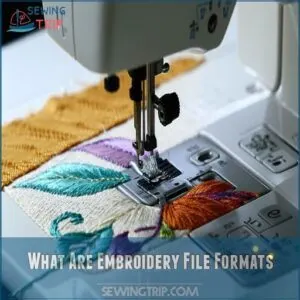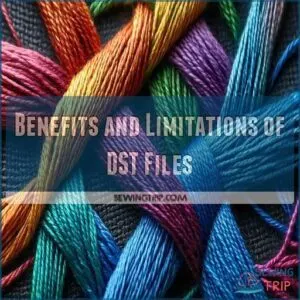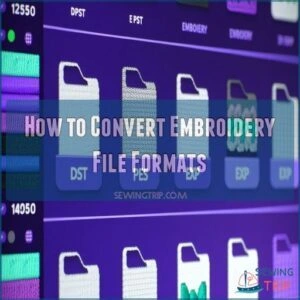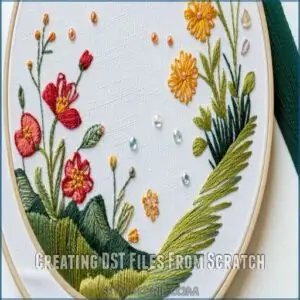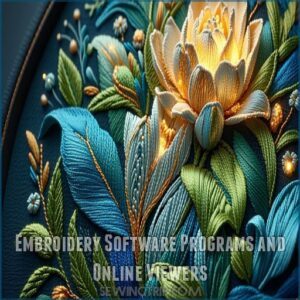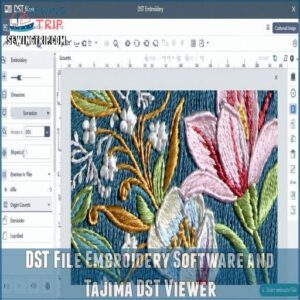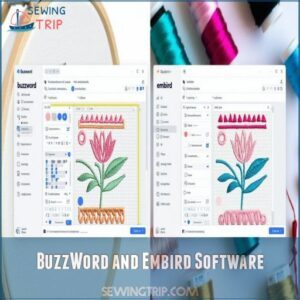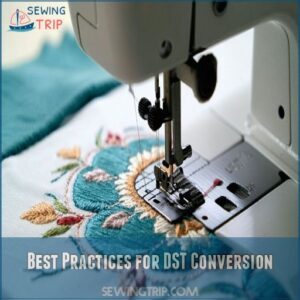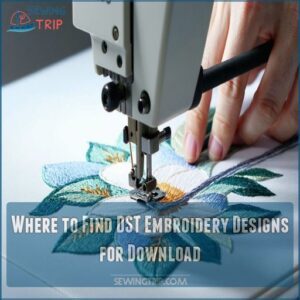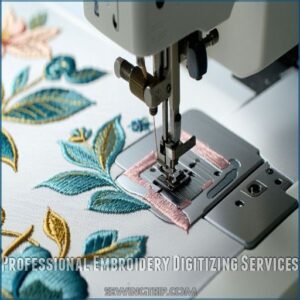This site is supported by our readers. We may earn a commission, at no cost to you, if you purchase through links.
 When you’re diving into embroidery, you’ll quickly discover the DST file format is your go-to universal language for machine designs.
When you’re diving into embroidery, you’ll quickly discover the DST file format is your go-to universal language for machine designs.
Created by Tajima, these files contain precise stitch instructions that tell your machine exactly how to recreate artwork. They’re compatible with most embroidery machines like Janome and Brother, making them a versatile choice for crafters.
While DST files support only a 10% size adjustment and lack thread color details, they’re still incredibly user-friendly.
You’ll need free conversion tools like My Editor or DIME Embroidery ToolShed to transform designs between formats.
Pro tip: Always test-stitch converted files to guarantee perfect replication.
Table Of Contents
- Key Takeaways
- What Are Embroidery File Formats
- What is a DST File for Embroidery
- Benefits and Limitations of DST Files
- How to Convert Embroidery File Formats
- Free Trials Worth Checking Out
- Creating DST Files From Scratch
- Opening and Viewing DST Files
- Best Practices for DST Conversion
- Where to Find DST Embroidery Designs for Download
- Professional Embroidery Digitizing Services
- Frequently Asked Questions (FAQs)
- Conclusion
Key Takeaways
- DST files: a universal language for embroidery machines, saving you hassle across brands like Janome and Brother.
- Converting designs: use free tools like My Editor or DIME Embroidery ToolShed, but always test-stitch your converted designs.
- DST file limitations: simple and beginner-friendly, but they lack thread color information and only support a 10% size adjustment; manual thread color selection is needed.
- Professional digitizing services: leverage these if you’re not confident creating DST files yourself for precise, machine-ready files and high-quality results.
What Are Embroidery File Formats
If you’re stepping into machine embroidery, you’ll quickly discover that embroidery file formats are the secret language machines use to understand and recreate your designs.
Each format, like DST, PES, or JEF, contains unique instructions.
These instructions tell your embroidery machine exactly how to stitch a pattern onto fabric.
Types of Machine Embroidery Files
Navigate the maze of embroidery file formats like a pro. You’ll encounter three key types of files that are essential for your digital stitching adventures: native design files, machine-specific formats, and universal formats. These digital blueprints determine how your designs translate across different embroidery machines.
Here’s what you need to know:
- Not all files work on every machine
- Each format speaks a different "language"
- Compatibility is king in embroidery
- Universal formats save you headaches
- Know your machine’s preferred file type
Mastering these formats means smoother, more successful embroidery projects.
Native Files and Machine Files
Imagine your embroidery design as a treasure map—native files are the original, detailed blueprint with every single mark and color plotted precisely.
These rich files live inside your embroidery software, preserving intricate design layers and thread color information.
Machine files, by contrast, are like simplified travel instructions your specific embroidery machine understands. They strip away the fancy details, only the core stitching commands, which is why they’ve evolved from Jacquard paper tapes to digital embroidery formats.
Different brands require different machine file formats, which means your carefully crafted native design might need translation. Think of it as converting a novel into a quick reference guide—same story, different presentation.
DST Files and Other Formats
If you’re diving into machine embroidery, DST files are your secret weapon. They’re the universal language machines understand, packed with precise stitch instructions and color change codes.
While they mightn’t carry thread color details, DST files work across brands like a Swiss Army knife.
Other formats like PES, JEF, and EXP cater to specific machines, but DST remains the go-to for design compatibility and flexibility.
Your embroidery journey starts here.
What is a DST File for Embroidery
After exploring machine embroidery file formats, you’re now zeroing in on the DST file – a true workhorse in machine embroidery.
Created by Tajima in the 1980s, these files are like digital roadmaps for your embroidery machine. They translate complex designs into precise stitch instructions using a straightforward coordinate system that guides your machine’s every move.
DST files are also limited to a 10% size adjustment, which is a key sizing accuracy consideration when working with embroidery designs.
A DST file strips design information down to its bare bones. It tells your machine exactly where to place each needle, tracking horizontal and vertical movements with pinpoint accuracy. Think of it as a machine-readable blueprint that works across different embroidery brands and models.
This universal format might seem simple, but it’s packed with power. DST files communicate stitch patterns through a universal language that machines understand, making them a go-to choice for embroiderers worldwide.
Benefits and Limitations of DST Files
When working with DST embroidery files, you’ll appreciate their universal compatibility across different machine brands, making them a go-to format for most embroidery enthusiasts.
However, you’ll want to keep in mind that these files lack thread color information, which means you’ll need to manually select colors during your embroidery project.
Compatibility With Various Machines
Tap into the power of DST files – your embroidery machine’s universal language.
These versatile files dance seamlessly across brands like Janome, Brother, Singer, and Bernina, breaking down machine compatibility barriers.
Most modern embroidery machines welcome these files, giving you the freedom to share, transfer, and stitch designs without wrestling with software limitations.
From commercial to home machines, DST files cut through conversion like a hot knife through butter.
Whether you’re a hobbyist or professional, DST files are the Swiss Army knife of embroidery design formats.
No headaches about file format problems – just pure, smooth embroidery design transfer across your favorite machines.
Lack of Thread Color Information
When your machine reads a DST file, you’ll face a color information roadblock. These files strip away thread color details, leaving you to play color detective.
You’ll need to manually select each thread shade before stitching – think of it like a blank canvas waiting for your artistic touch.
Professional digitizers recommend keeping color palettes handy or using alternative DST file formats that preserve color information.
Some embroidery software offers workarounds, letting you map colors before stitching. It’s an extra step, but with practice, you’ll master the color input dance.
Simple and Beginner-Friendly
Embroidery newbies, meet your digital sidekick: the DST file format. This beginner-friendly design standard is like training wheels for machine embroidery, offering a smooth learning experience for crafters just starting out.
- Foolproof compatibility across most embroidery machines
- Simple, straightforward file structure that’s easy to understand
- Free conversion tools make experimenting a breeze
Many embroidery machines, including the best embroidery machine for beginners, can read DST files with ease.
Whether you’re downloading free DST files or trying easy DST editing, this format eliminates technical headaches. Basic software handles these files effortlessly, letting you focus on creativity instead of complicated technical details. Your embroidery journey just got way simpler – no advanced skills required.
How to Convert Embroidery File Formats
If you’re working with embroidery files, you’ll need to know how to convert between different formats.
To match your machine’s requirements.
Understanding file conversion techniques can save you time and frustration.
Ensuring your designs stitch out perfectly every time.
Free Converters and Specialized Software
When working with embroidery file formats, free converters can save the day.
You’ll find handy tools like My Editor and DIME Embroidery ToolShed that can transform your designs without emptying your wallet.
Before diving into paid options, explore free trials and remember to test-stitch your converted designs.
| Software | Cost | Conversion Quality |
|---|---|---|
| My Editor | Free | Moderate |
| DIME Tools | Free | Good |
| Open-Source | Free | Variable |
| Paid Software | $ | High |
| Trial Versions | Free | Limited |
DIME Embroidery ToolShed and My Editor
DIME Embroidery ToolShed and My Editor are lifesavers when working with the DST file format and other embroidery file formats. These free tools make converting files a breeze with their simple interfaces and accurate results.
- Fast conversion speed handles tasks quickly.
- Reliable file compatibility supports smooth machine use.
- User-friendly ToolShed interface simplifies navigation.
- My Editor review tools help inspect designs.
- Minimal software limitations keep things efficient.
BERNINA ARTlink 9 and Other Options
BERNINA’s ARTlink 9 features make it perfect for beginners, offering simple file compatibility and quick conversions suited to embroidery file formats like DST.
Looking for ARTlink 9 alternatives? Try Embrilliance for pro-level editing, Ink/Stitch for vector-friendly designs, or StitchBuddy for mobile convenience.
These embroidery software options cover all conversion tips your embroidery machine might need for DST files.
| Software | Free/Paid | Key Features | Best For |
|---|---|---|---|
| ARTlink 9 | Free | Basic conversion | Beginners |
| Embrilliance | Paid | Advanced editing | Professionals |
| Ink/Stitch | Free | Vector support | Designers |
| StitchBuddy | Free | Mobile friendly | On-the-go |
Free Trials Worth Checking Out
Many software options offer free trials.
You don’t have to spend money right away to try out embroidery file conversion tools.
WilcomWorkspace Studio and SewWhat-Pro
WilcomWorkspace Studio and SewWhat-Pro both offer free trials perfect for exploring embroidery software. Wilcom’s professional-grade tools let you convert to DST easily while keeping things user-friendly. SewWhat-Pro is great for handling embroidery file formats, especially with its batch conversion feature. Both support DST file format with live previews.
- Wilcom blends advanced features with simplicity.
- SewWhat-Pro focuses on practical conversions.
- Test trials confirm compatibility before committing.
BuzzXplore and Embroidery Design Converter
BuzzXplore features make it a go-to for converting embroidery designs, especially in the DST file format. With support for 45+ formats, advanced previews, and batch options, it’s incredibly versatile.
The Embroidery Design Converter is simpler, offering basic previews but fewer formats and limited batch conversion.
Both BuzzXplore and the Embroidery Design Converter shine with free trials—BuzzXplore offers 30 days, while its alternative provides 14 days.
Considering the importance of native file formats for digitizing, selecting the right conversion tool is essential.
Test these software options to handle embroidery file format DST conversions smoothly!
Hatch 3 Digitizer and Other Software
Hatch 3 Digitizer makes embroidery digitizing a breeze with high-quality tools and a free 30-day trial. Explore file format support and customization features without pressure. Compare it with alternatives like Embrilliance or PE-Design.
Explore these benefits:
- Advanced auto-digitizing.
- Flexible pricing plans.
- Powerful lettering.
- Wide DST file format compatibility.
- Easy-to-learn interface.
Creating DST Files From Scratch
Creating DST files from scratch requires the right software and some knowledge of embroidery design basics.
With programs like SewArt or Wilcom EmbroideryStudio, you can manually create stitch-perfect designs for your projects.
Manual Creation and Software Requirements
Creating DST files takes patience and the right setup, but it’s a skill worth mastering.
Start by choosing embroidery digitizing tools suited to your design complexity and skill level. You’ll also need to consider file size limits while balancing stitch density control for smooth results.
Here’s what you’ll need to succeed:
- Embroidery software supporting JPG files, vector imports, and DST file exports.
- Knowledge of stitch types and how fabric properties impact designs.
- A firm grip on your machine’s specifications.
The learning curve for creating DST files can be intimidating, but with the right DST file editor and practice, you’ll tap into the creative potential in the DST file format for custom embroidery projects.
SewArt and Wilcom EmbroideryStudio
Creating DST files can be achieved with two popular options: SewArt and Wilcom EmbroideryStudio.
SewArt, priced at $75, is ideal for beginners with its user-friendly interface and basic auto-digitizing features. SewArt limits itself to hobby projects.
Wilcom EmbroideryStudio, costing over $2,500, offers professional-grade tools and advanced auto-digitizing capabilities. It is for those seeking excellent stitch quality and a wide range of supported file formats.
For in-depth guidance on mastering Wilcom DST, tutorials are available for purchase online, such as those found at Wilcom DST tutorials.
Opening and Viewing DST Files
You can open and view DST files using embroidery software or free online tools. Programs like Embrilliance or Tajima DST Viewer make it simple to check your designs.
Embroidery Software Programs and Online Viewers
Viewing DST embroidery files doesn’t have to be complicated. Reliable software can simplify the process.
For those looking for additional tools and resources, a dedicated DST file viewer can be a valuable asset.
Here’s a quick breakdown of tools worth exploring:
- Embrilliance Express Viewer – Completely free and ideal for beginners dipping into embroidery.
- SewWhat-Pro – Affordable, user-friendly, and packed with handy features.
- Wilcom TrueSizer – Offers unmatched compatibility across file types.
- StitchBuddy – Perfect for quick previews and simple editing.
These tools balance functionality, pricing models, and intuitive user interfaces.
DST File Embroidery Software and Tajima DST Viewer
Looking for simple DST file viewers?
Tajima DST Viewer and other embroidery software are great tools for checking designs before stitching.
Tajima’s software shows stitch counts, dimensions, and lets you adjust things like size or rotation.
Whether you’re tweaking a design or previewing it, these programs streamline your process.
It’s a must-have if you’re serious about working with the DST file format.
BuzzWord and Embird Software
If you’re managing embroidery files, BuzzWord and Embird are worth checking out. Both handle the DST file format efficiently, with tools that simplify your work.
- Embird features like advanced editing make file adjustments easy.
- Great file compatibility, covering a variety of embroidery machines.
- User-friendly interfaces save time.
While BuzzWord is solid, Embird stands out for its versatility, reliability, and glowing user reviews.
Best Practices for DST Conversion
When converting to DST, focus on accuracy to guarantee your design stitches smoothly. Use the right software and settings for reliable results.
Spot-Checking Results for Accuracy
Test stitches are vital when working with the embroidery file format DST. Always inspect your design for stitch density, missing details, and placement issues.
Are tiny details distorted or lost? Adjust them early. DST files don’t save thread colors, so outline sections clearly for easy adjustments.
Spot file corruption by comparing your original design with the converted one. This practice guarantees clean embroidery digitizing DST and accurate designs every time.
To guarantee seamless results, consider the importance of vector-based formats for editability and machine-readable extensions.
Choosing The Right Software and Settings
Step into the world of embroidery software with a strategic approach to picking your perfect digital companion. Your machine’s unique needs dictate your choice: Consider exploring the best dst software options available to find the ideal fit.
To pick the right software, consider the following key factors:
- Match software compatibility with your embroidery machine
- Weigh user-friendliness against advanced feature sets
- Check file size before committing
- Prioritize stitch density and color accuracy settings
Pro tip: Start with default configurations and tweak as you go.
Understanding Design and Fabric Parameters
| Fabric Type | Stitch Density Recommendation |
|---|---|
| Light Fabrics | Lower density to prevent puckering |
| Medium Fabrics | Balanced stitch placement |
| Heavy Fabrics | More complex design support |
| Delicate Materials | Shorter stitch lengths |
Every fabric whispers its own embroidery secret. Your design’s success hinges on understanding these textile nuances. Stitch density isn’t just a number—it’s your roadmap to embroidery perfection.
Light fabrics demand a gentle touch, while heavyweight materials welcome intricate patterns. Consider your thread choice carefully, matching it to fabric suitability and design complexity.
The right stitch length can transform a good design into a stunning masterpiece of textile art. A range of light to dark Fabric Values in Collage can also add depth and dimension to your embroidery design.
Where to Find DST Embroidery Designs for Download
Machine embroidery can be a challenge when it comes to finding quality DST designs. Your quest for stunning embroidery doesn’t have to drain your wallet or test your patience.
Here are three golden rules for finding incredible designs:
- Explore niche marketplaces like Embroidery Library and Urban Threads, where curated collections come with detailed previews and reliable file formats.
- Tap into Etsy shops run by independent designers who often provide multiple file formats, including DST, with professional-grade artwork.
- Leverage free design websites such as Embroideres.com and member-driven forums like Secrets of Embroidery for budget-friendly options.
When downloading DST embroidery designs, always check seller ratings and read user reviews. Many sites offer free sample designs, letting you test quality before committing. Pro tip: Join member-driven forums where crafters exchange designs, share weekly freebies, and offer valuable feedback.
Don’t just download—verify. Each design should match your machine’s specifications and fabric requirements. Your perfect embroidery design is out there, waiting to transform your next project.
Professional Embroidery Digitizing Services
If you’re struggling to convert your artwork into a perfect embroidery design, professional digitizing services can save you time and frustration.
These expert services transform your images into precise, machine-ready DST files.
That’ll make your embroidery projects look polished and professional.
Auto Digitizing and Professional Companies
Several exceptional embroidery digitizing services can transform your creative vision into professional DST files.
These experts offer cost-effective solutions with lightning-fast turnarounds and stellar design quality.
By comparing customer service, pricing, and portfolio options, you’ll find the perfect partner to breathe life into your embroidery.
Whether you’re a hobbyist or pro, professional digitizing services bridge the gap between imagination and stunning embroidered masterpieces.
Free Digitizing Software and Alternatives
Want to tap into your creativity without breaking the bank? Free digitizing software opens doors to embroidery design magic!
Open-source options like Ink/Stitch let you transform images into DST files without spending a dime.
Professional software offers free trials, but these alternatives provide a budget-friendly path to embroidery digitizing.
Evaluating your needs and budget can also help you choose the right software, whether you’re a hobbyist or professional, and considering compatibility with your embroidery machine.
Check user reviews to navigate the learning curve, and explore free DST file resources.
From WilcomWorkspace trials to community-driven tools, you’ll find cost-effective ways to bring your embroidery designs to life without emptying your wallet.
Frequently Asked Questions (FAQs)
What kind of free embroidery designs do you offer?
You’ll find free designs on sites like Embroideres.com and EmbroideryShristi, offering basic patterns.
Community forums like Secrets of Embroidery also share designs, giving you plenty of creative options to explore.
How do I download your free embroidery designs?
Hold onto your bobbin, crafty friend!
Our free embroidery designs aren’t directly available for download.
Check our website’s design marketplace, browse available collections, and follow the purchase or registration process to access designs.
How Do I Convert a Jpeg to a Dst File?
Use specialized software like SewArt or hire a professional digitizing service to transform your JPEG.
These tools carefully translate your image into precise stitch instructions that embroidery machines can read and reproduce.
How Do I Convert Embroidery to Dst?
When creativity meets technology, converting embroidery designs becomes a breeze.
You’ll need specialized digitizing software like Embrilliance or SewArt.
To transform your artwork into a machine-friendly DST file that stitches perfectly.
What Programs Create Dst Files?
You’ll need specialized digitizing software like SewArt, Wilcom EmbroideryStudio, or Embird to create DST files.
These programs let you transform designs, control stitch types, and prepare embroidery patterns for machine stitching.
How Do I Convert a File to Dst?
Use free online converters like Tajima Ambassador or specialized software such as Embrilliance and Wilcom to transform your image or design file.
Always test the converted DST file on your specific embroidery machine first.
What is a DST format for embroidery files?
A DST file is your embroidery machine’s secret recipe for creating designs.
It contains precise stitch instructions and color change commands, telling your machine exactly how to transform fabric into beautiful artwork.
How do I convert a jpg to DST embroidery?
Wanna turn your JPEG into an embroidery masterpiece? Grab SewArt or hire a digitizing pro to transform your image into a machine-friendly DST file that’ll bring your design to life.
What software is used for DST embroidery files?
You’ll need specialized software like Embrilliance Essentials, Wilcom Hatch, or SewWhat-Pro to work with DST embroidery files.
These tools help you open, edit, and convert designs across different embroidery machine formats.
How can I open DST embroidery files?
Whispers of digital stitchery reveal their secrets through specialized viewers. You can peek into DST files using free software like Embroidery Explorer, online platforms such as FileProInfo, or Wilcom TrueSizer.
Conclusion
Ready to take your embroidery skills to the next level with DST file formats?
Understanding these digital design blueprints can transform your crafting journey.
Whether you’re converting files, exploring free tools, or testing new designs, the embroidery file format DST offers endless creative possibilities.
Master the conversion techniques, experiment with software, and watch your machine bring intricate artwork to life.
Your next masterpiece is just a stitch away!

